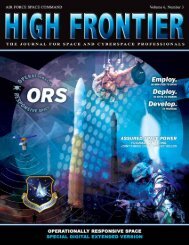Space Acquisition - Air Force Space Command
Space Acquisition - Air Force Space Command
Space Acquisition - Air Force Space Command
Create successful ePaper yourself
Turn your PDF publications into a flip-book with our unique Google optimized e-Paper software.
tions. The 526 ICBMSG provides single program management<br />
for the entire lifecycle of the Minuteman III weapon system. In<br />
summary, these organizations encompass the scope of nuclear<br />
weapon system support functions that include sustainment,<br />
modernization and acquisition support activities for the Department<br />
of Defense and Department of Energy.<br />
The Role of the 526 ICBM Systems Group<br />
The 526 ICBMSG is responsible for inception-to-retirement<br />
weapons system management of the nation’s land based strategic<br />
deterrent. The group began in July 1954 to develop the Titan<br />
I ICBM and intermediate range ballistic missiles and was later<br />
re-designated as the <strong>Air</strong> <strong>Force</strong> Ballistic Systems Division and<br />
then the Ballistic Missile Office responsible for developing and<br />
fielding the nation’s ICBM fleets of Atlas, Titan, Minuteman I,<br />
II, III, and Peacekeeper<br />
weapons systems<br />
from 1962 to 1987.<br />
In 1993, the organization<br />
merged with the<br />
ICBM Product Directorate<br />
to form the<br />
ICBM Systems<br />
Program Office.<br />
The ICBM<br />
system program<br />
office (SPO) was<br />
responsible for completing<br />
the deployment<br />
of Peacekeeper, long-term<br />
sustainment of the ICBM fleets, as<br />
well as planning the next generation missile system. When the<br />
decision was made to extend the life of the Minuteman III fleet<br />
in 1995, the SPO embarked upon several major modifications<br />
to extend the service life to 2020. The ICBM fleet was downsized<br />
in 2005 with the deactivation of 50 Peacekeeper missiles<br />
and a subsequent reduction in the Minuteman III fleet to 450<br />
missiles on alert. Today, the 526 ICBMSG is charted to sustain<br />
and modernize the current Minuteman III fleet through 2030<br />
and to manage any developmental work for a follow-on system<br />
as required by the warfighter to continue to ensure the viability<br />
of the nation’s land based strategic deterrent.<br />
The Future and Focus of the <strong>Air</strong> <strong>Force</strong> Nuclear<br />
Weapons Enterprise<br />
The AFNWC continues with its charter of nuclear consolidation,<br />
successfully integrating new units and new personnel.<br />
With the recent introduction of new maintenance, technical,<br />
and program management units into the center, a critical mass<br />
of common missions has become obvious. In the near future,<br />
the center will integrate nuclear weapons maintenance and<br />
storage operations throughout the continental US and will add<br />
much needed expertise throughout the organization, bringing<br />
on nearly 300 new personnel. Synergy will be even greater<br />
under the next phases of the center’s growth and the safeguarding<br />
of the <strong>Air</strong> <strong>Force</strong>’s and our nation’s nuclear expertise will be<br />
paramount amongst the center’s plans and priorities.<br />
All of these changes directly support the <strong>Air</strong> <strong>Force</strong>’s goals<br />
to re-establish a nuclear culture of discipline and accountability,<br />
rebuild the nuclear expertise, invest in nuclear capabilities,<br />
organize to enable clear lines of authority, and reinvigorate our<br />
<strong>Air</strong> <strong>Force</strong> nuclear stewardship role.<br />
References:<br />
“History of Minuteman Missile Sites,” History of the Minuteman<br />
Missile, US Department of the Interior/National Park Service; Source:<br />
Minuteman Missile Sites: Special, Resource Study, 1995, www.nps.gov/<br />
archive/mimi/history/srs/criteria.htm.<br />
“A Guide to Nuclear Weapons,” The Nuclear Weapon Archive, http://<br />
nuclearweaponarchive.org.<br />
“History of Nuclear Weapons,” <strong>Air</strong> <strong>Force</strong> homepage, www.af.mil/<br />
main/welcome.asp.<br />
“Our History” Parts 1-4, <strong>Air</strong> <strong>Force</strong> Official Web site, http://www.airforce.com/learn-about/history/.<br />
Col James D. Fisher (BS<br />
Electrical Engineering, Ohio<br />
University; MS, Business<br />
Administration and General<br />
Management, Lesley University,<br />
Massachusetts) is<br />
the commander, 526 th Intercontinental<br />
Ballistic Missile<br />
(ICBM) Systems Group. The<br />
group is a tenant unit on Hill<br />
AFB and an AFMC Group<br />
reporting to the <strong>Air</strong> <strong>Force</strong><br />
Nuclear Weapons Center located<br />
at Kirtland AFB, New<br />
Mexico. The group is responsible for inception-to-retirement<br />
integrated weapons system management of the Minuteman and<br />
Peacekeeper ICBM weapon systems. The group develops, acquires,<br />
and supports silo based ICBMs, while providing program<br />
direction and logistics support as the single face to the customer.<br />
The group is also responsible for acquisition, systems engineering,<br />
and depot repair; manages equipment spares, provides storage,<br />
and transportation; and accomplishes modifications and<br />
equipment replacement to maintain silo-based ICBM systems.<br />
Colonel Fisher has been a missile launch officer, guidance<br />
system engineer/program manager, tech advisor to the assistant<br />
secretary of state for political–military affairs; <strong>Air</strong> <strong>Force</strong> <strong>Space</strong><br />
<strong>Command</strong> lead for the Evolved Expendable Launch Vehicles<br />
Program; commander, Ascension <strong>Air</strong> Field South Atlantic Ocean;<br />
commander, National Reconnaissance Office (NRO) Communications<br />
Operations Launch Squadron; chief of safety and environmental,<br />
NRO Office of <strong>Space</strong> Launch; chief engineer, NRO Office<br />
of <strong>Space</strong> Launch; and substituted as deputy mission director<br />
on a recent NRO launch. He has worked in operations, requirements,<br />
acquisition, and political-military affairs while working<br />
in Office of the Secretary of Defense, two major commands, the<br />
intelligence community, and overseas.<br />
Colonel Fisher is currently an engineer in training through the<br />
National Society of Professional Engineers, a project manager<br />
through Project Management Institute, and holds a Foundation<br />
Certificate in Information Technology Infrastructure Library.<br />
High Frontier 34











